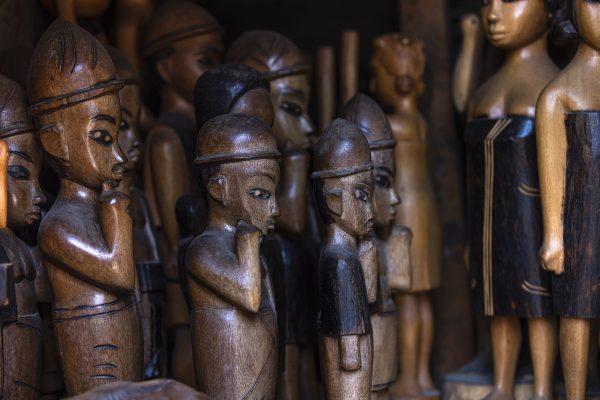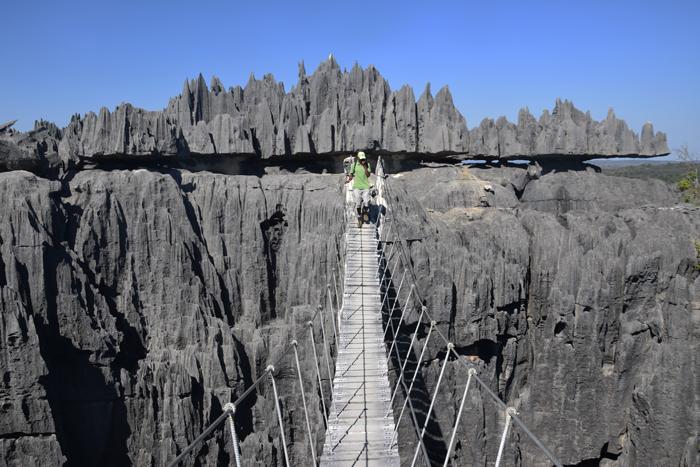Explore the cultural richness and exceptional biodiversity of Madagascar through its UNESCO World Heritage sites, natural and cultural jewels to discover in the Big Island.
The art of Zafimaniry :

The Zafimaniry wood art of Madagascar is an outstanding example of the island’s traditional craftsmanship, which was recognized by UNESCO in 2003 as an Intangible Cultural Heritage Site of Humanity. This woodcarving technique originated in the Zafimaniry region, located in the mountainous area southeast of Ambositra, where it has been practiced for generations by the Zafimaniry ethnic group.
The Zafimaniry are very good at architecture. These houses are built of cedar, rosewood and other local tree species, which are then carved with intricate geometric patterns called Sokitra. The patterns are inspired by nature and daily life, and are often used to tell local stories or myths.
This perfect mastery of wood has been passed down from generation to generation through informal learning methods. Zafimaniry artisans have a thorough knowledge of the nature and properties of wood, as well as the tools and techniques needed to work with wood. Carvers use tools such as axes, knives and gouges to shape the wood, while more specialized artisans use more precise tools to create more detailed designs.
Moreover, wood art is deeply rooted in the culture and daily life of the Zafimaniry ethnic group. Carved wooden houses are considered symbols of wealth and prestige, as well as places of worship and ceremony. However, this know-how is now threatened by modernization and globalization. Most of the young people in the community are no longer interested in traditional crafts, preferring to work in more lucrative jobs in the cities. In addition, deforestation and the illegal wood trade threaten the types of trees used for carving.
The sacred hill of Ambohimanga:

The sacred hill of Ambohimanga, located about 24 kilometers northeast of Antananarivo, is a major cultural and historical site of Madagascar. Classified as a UNESCO World Heritage Site in 2001, the sacred hill of Ambohimanga was an important center of political and religious power in the history of the Merina kingdom.
Ambohimanga, which literally means “the blue hill”, has been considered sacred for centuries. It was a place of religious ceremonies and rituals of the Merina royal foko, which dominated Madagascar from the 17th to the 19th century. The sacred hill was also the residence of the Merina rulers until the French colonization of Madagascar in 1895.
This hill is composed of several important sites, such as the remains of palaces, royal tombs and fortifications, which testify to the rich and complex history of Madagascar. The site is surrounded by a sacred forest, which is home to many species of trees and medicinal plants. One of the most important sites on the sacred hill is the Rova of Ambohimanga, which was the royal residence of the Merina rulers. The Rova was built in the 18th century and is a remarkable example of traditional Merina architecture, with walls made of earth and carved wood, as well as thatched roofs.
Also associated with many local legends and beliefs. According to one legend, the hill was created by a giant who threw a handful of earth into the Indian Ocean, thus creating Madagascar. Another legend tells that the hill was inhabited by spirits, who chose the Merina rulers as their representatives on earth.
Despite its cultural and historical significance, the sacred hill of Ambohimanga is threatened by environmental degradation and human activities. The sacred forest is threatened by deforestation and the expansion of urban areas, while the remains of the sacred hill are vulnerable to damage by tourists and visitors.
The National Park of Tsingy de Bemaraha:

The Tsingy de Bemaraha National Park, located in the Menabe region of Madagascar, is a unique geological site in the world. It was classified as a UNESCO World Heritage Site in 1990 for its exceptional beauty and ecological value.
The name “Tsingy” means “the place where you can’t walk barefoot” in Malagasy, referring to the sharp shape of the limestone peaks that characterize the park. These peaks are formed by the erosion of the limestone rock, creating amazing geological formations of all sizes and shapes. The Tsingy de Bemaraha National Park covers more than 150,000 hectares and is divided into two parts: the large Tsingy and the small Tsingy. The big Tsingy is the most spectacular part of the park, with 50 meters high limestone peaks, hanging bridges, caves and canyons. The small Tsingy is also impressive, with smaller but equally sharp peaks.
The National Park of Tsingy de Bemaraha shelters an incredibly rich and varied fauna and flora. It is part of one of the largest protected sites of the island. There are 13 species of lemurs, including the Eulemur rufus, the Sifaka of Deckeni and the very rare aye-aye. It is also one of the few places in the world where you can find the fossa, the largest predator of Madagascar, and nearly a hundred land and water birds, including the Ankoay, the eagle endemic to Madagascar.
The flora of the park is equally diverse. Tsingy de Bemaraha is home to over 650 species of plants, many of which are endemic to Madagascar. The rock formations of the park create unique microclimates where certain plants can grow. Visitors can discover carnivorous plants, orchids, baobabs and many other species.
Marojejy Massif National Park:
The Massif du Marojejy National Park is one of Madagascar’s biodiversity gems. Located in the northeast of the island, this national park covers more than 60,050 hectares and includes the Marojejy Massif, a steep mountain range covered in tropical rainforest. The park was established in 1952 and has since become one of the most important biodiversity conservation sites in Madagascar.
The Marojejy Massif is home to a rich diversity of plant and animal species, many of which are endemic to Madagascar. The park is home to several species of lemurs, including the critically endangered Silky Sifaka, which is endemic to the region.
The forest of the Marojejy massif is also rich in plant species. Tree ferns and orchids are common in the forest, as are giant trees and lianas. Some of the forest’s most notable plants include the Dypsis marojejyi palm, a rare and endangered species found only in the Marojejy Massif, and the rosewood, a precious tree found throughout Madagascar.
Cap Masoala National Park:
Part of the rainforests of Antsinana like Marojejy. The park is located on the northeastern tip of the island and is bounded on the west by the Bay of Antongil and on the east by the Indian Ocean. The park covers more than 240,000 hectares and encompasses a wide variety of ecosystems ranging from tropical rainforests to white sandy beaches and coral reefs.
The Cap Masoala National Park was created in 1997 to protect the unique biodiversity of this region. The park is home to a rich variety of animal and plant species, many of which are endemic to Madagascar. The park is home to several species of lemurs, including the black lemur, ring-tailed lemur, red-bellied lemur and Milne-Edwards lemur. The park is also known to be home to the largest group of Aye-aye lemurs, a rare and mysterious primate that is considered one of the world’s strangest animals.
Also rich in plant species. The tropical rainforests are home to a wide variety of trees, vines and epiphytic plants. Some of the park’s most notable plants include the Dypsis decaryi palm, a rare and endangered species found only in this region, as well as the traveler’s tree, an iconic symbol of Madagascar.The land and sea park is also known for its white sand beaches and coral reefs. Visitors can discover a wide variety of tropical fish, sea turtles and other marine species while diving or snorkeling.
Ranomafana National Park:
Located in the Highlands of Madagascar between the regions Haute-Matsiatra and Vatovavy Fitovinany. The park covers more than 40,000 hectares of lowland dense rainforest (600-800m) and mediumland dense rainforest (800-1400m), as well as savannah. The park was created in 1991 to protect the natural habitat of lemurs and other endemic species of the region.
The park is famous for its fauna, there are currently: 6 species of fish, 74 species of insects, 90 species of butterflies including 4 rare species, 350 species of spiders, 6 endemic species of crustaceans and a subspecies of crayfish of the group of Astacoides. 58 species of reptiles, 98 species of amphibians, 115 of the 257 species of birds of Madagascar, the majority of which are endemic. 12 species of lemurs, 7 species of carnivorous mammals and 20 species of insectivores, 07 species of chiropterans including the Myzopoda aurita, a monogenre that exists only in Madagascar. And also 13 species of rodents.
The park offers a wide variety of activities for visitors, including forest walks, boat rides on the Namorona River, and visits to traditional villages. Visitors can also enjoy the natural thermal baths of Ranomafana, which are renowned for their therapeutic properties.
The national park of Zahamena:
Zahamena National Park, located in the Alaotra-Mangoro region, covers an area of 64,200 hectares and is home to an incredible biodiversity.Zahamena is considered one of the most important national parks in Madagascar in terms of biodiversity conservation. The park consists mainly of primary and secondary forests, with altitudes ranging from 800 to 1,800 meters. It is also crossed by several rivers and streams, the most important of which is the Sahatandra River.
The park is home to a wide variety of fauna and flora. These include lemurs, birds, reptiles, amphibians, butterflies and many medicinal plants. Lemurs are the most popular animals in Madagascar, and Zahamena Park is one of the best places to observe them in their natural habitat. It is possible to encounter several species of lemurs in the park, including the Silky Sifaka, the Brown Lemur and Milne-Edwards’ Sifaka.
Zahamena National Park is an ideal place for hiking and nature observation enthusiasts. The park has several hiking trails, which offer incredible views of the forest and river. Visitors can also go on night hikes to observe nocturnal wildlife.
The national park of the Andringitra massif:
The Andringitra Massif National Park is a natural jewel located in south-central Madagascar. With an area of 31,160 hectares, it is one of the largest national parks in Madagascar. The Andringitra Massif is a popular hiking destination for nature and mountain lovers, with peaks reaching more than 2,600 meters in altitude.
The park is home to incredible biodiversity, with more than 100 species of endemic plants and numerous animal species, including lemurs, birds, reptiles and amphibians. The most famous lemurs in the park are the Vari Roux and the Catta Lemurs. The Andringitra massif is also known for its impressive geology, with spectacular rock formations and waterfalls.
For hiking lovers, Andringitra National Park offers a variety of hiking trails, ranging from simple strolls to more challenging and technical hikes. The most famous peak in the park is Pic Boby, which offers a panoramic view of the surrounding mountains.
Andohahela National Park:
Andohahela National Park is a natural park located in the south of Madagascar, near the town of Tôlanaro. With an area of 76,020 hectares, it is one of the largest national parks in Madagascar and one of the most important in terms of biodiversity.
Andohahela National Park is described as a center of a wide variety of ecosystems, ranging from tropical rainforest to rock formations and savannas. This unique ecosystem contains numerous plant and animal species, many of which are endemic to Madagascar. These include lemurs, birds, reptiles, amphibians, butterflies and medicinal plants.
The national park is divided into three main zones: the mountain forest, the lowland forest and the dry forest. Each of these areas has its own characteristics and offers a different hiking experience. Also an important place for scientific research.






